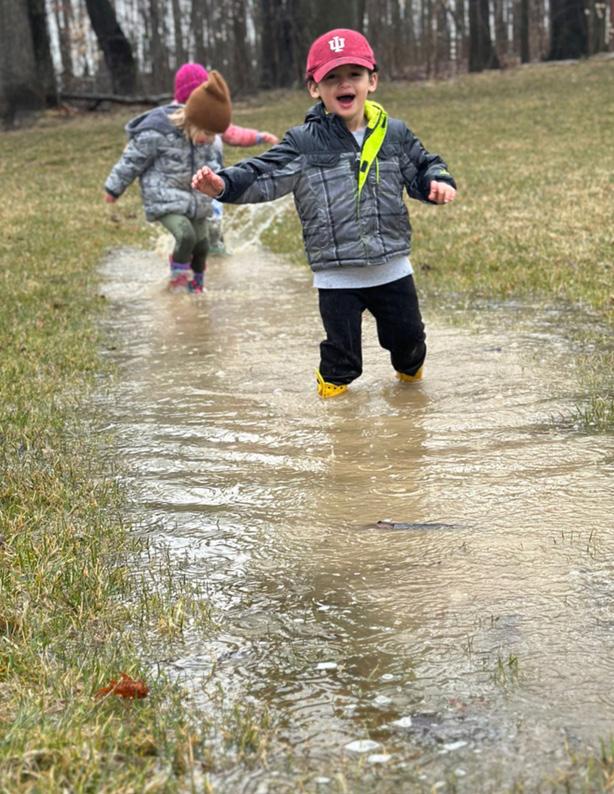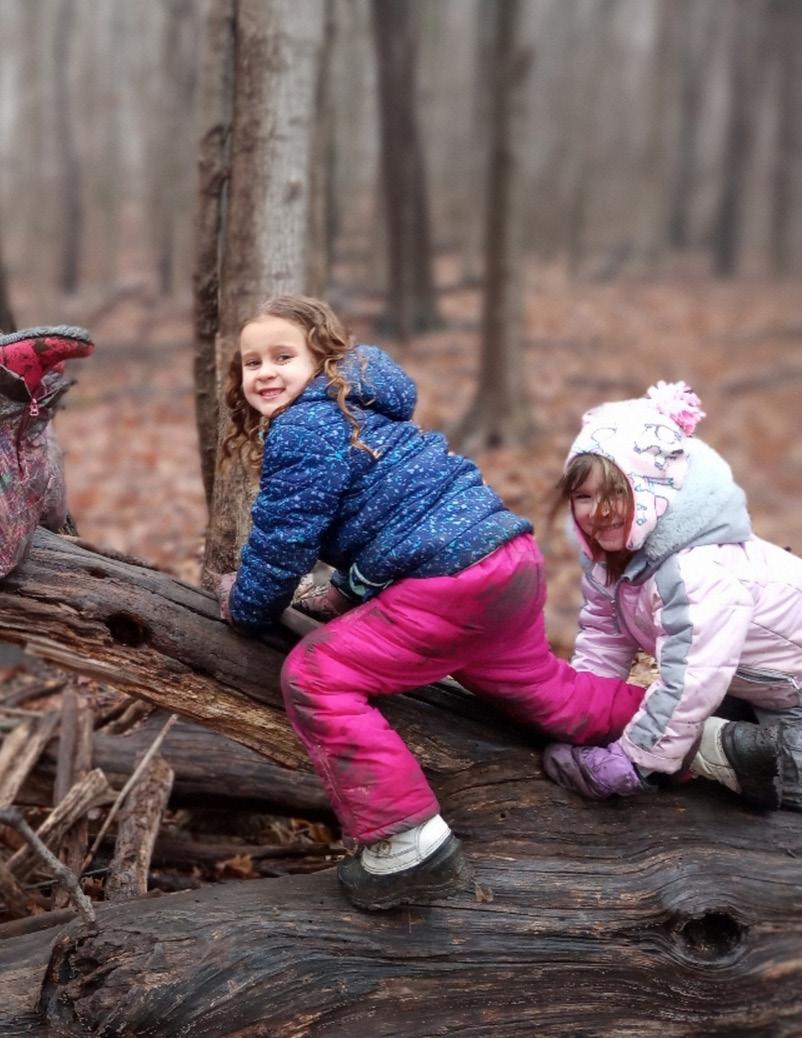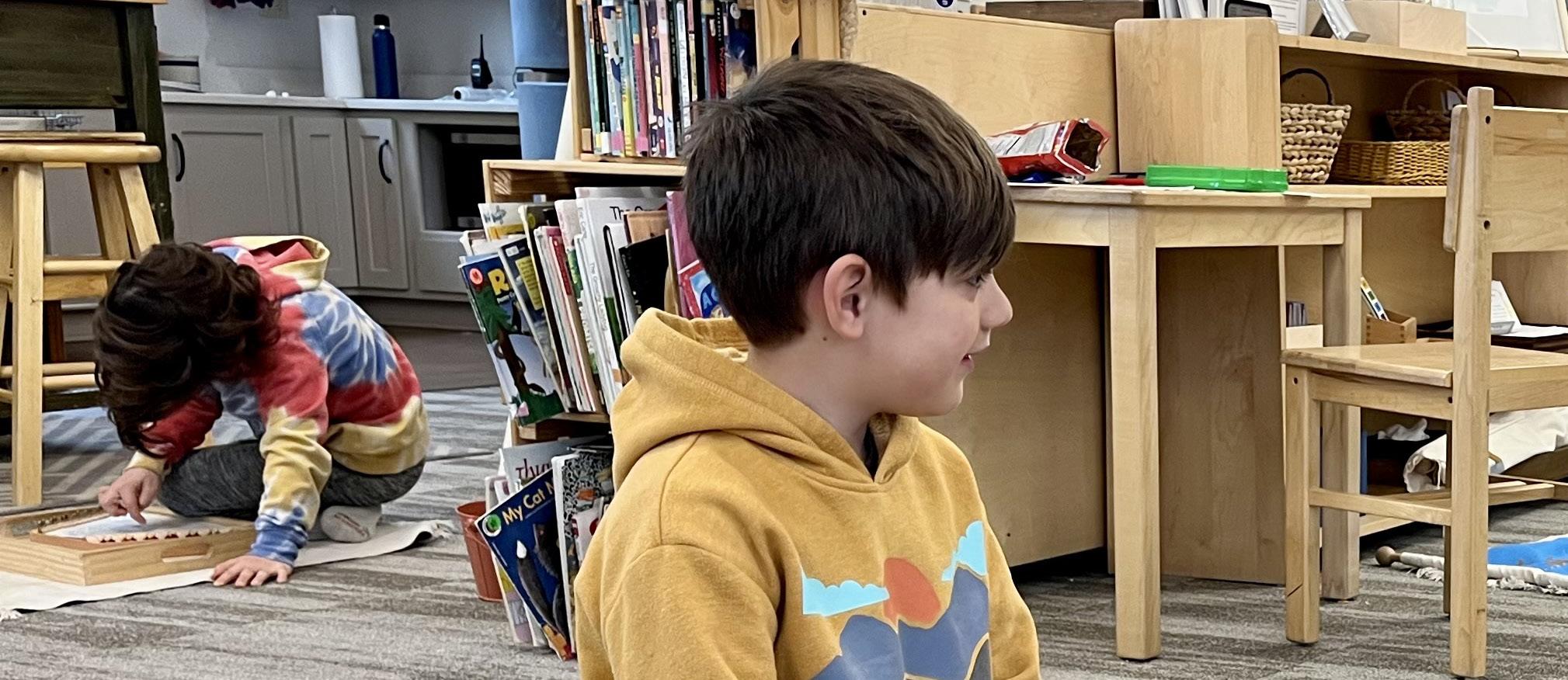
7 minute read
Oak Farm Montessori
May 2023
Your thumb and forefinger pinch and expand the blue sphere of swirling white clouds and land masses of the earth. What originally looked fairly similar, zooms in to reveal various topography features, architecture, and ecology. Dr. Maria Montessori desired a world where the child would learn not only the physical and evolutionary aspects of the world, but its ecological functioning and the role that humans play in its continuation; she called it Cosmic Education.

But how do you present such weighty topics to preschool children? You take them outdoors! You introduce them to the flora and fauna, the lifecycle of the butterfly, or the strength it takes to pull a wagon full of dirt. These simple lessons show the connectivity we each have to the world around us; how caring and respecting the environment means it will be there for others to enjoy.
At the elementary level, The Great Lessons are revealed. Students hear stories of The Coming of the Universe, The Coming of Life, The Coming of Numbers and The Coming of Humans. But, unlike a mathematical equation to memorize, these lessons are to invoke a line of inquiry in each student. “What is my place in the universe? My role as a citizen? Or, Who am I as an individual?” Cosmic Education provides the foundation for discovering the interconnectedness between ourselves, other living organisms and the universe. Students may document phenology, trace their genealogy or research ancient Egyptian civilizations.
At the secondary level, the cosmic agents learned in elementary: land, air, water, energy, plants and animals, and humans converge in the Erdkinder program. At middle school, adolescents care for animals, tend to the land, grow plants, work with one another, and learn the basics of running a micro economy. Finding purpose in the present, understanding of the past and preparing for future endeavors; they are developing their own cosmic task. High school students are preparing for occupations, independence, leadership and valorization. The opportunity to try various pathways or internships to discover their passion is encouraged and expected. Intersession trips introduce students to new cultures, diverse ecological environments and lessons in emotional literacy.
Dr. Montessori said that, “The child is both a hope and a promise for mankind.” I believe that she designed her pedagogy to free the child’s potential; inspiring them to think for themselves and see the beauty in the world around them. In its most basic terms, Cosmic Education is moving from the whole to the detail, seeing how one affects the other. So zoom in on that vacation destination, because it really is a small world after all…
Candice
Nature explorers
Danielle Norris, Toddler assistant & Nikole albright
Cosmic education is the cornerstone of Montessori philosophy; it tells a story of how all things connect in one way or another. Dr. Maria Montessori believed that to achieve comprehensive, holistic, and purposeful development of the whole person, they needed to discover and pursue their individual cosmic task.
Beginning with the foundation of the natural world around them, Montessori believed it was vital to early education for children to spend time in nature and to experience the sensorial aspects it provides. A walk through the woods reveals the identification of various bird species by their trills, splashing through the mud puddles on a rainy day provides an explosion of sights and sounds, while climbing on a fallen tree limb helps provide lessons in balance and proprioceptive skills. While this young child may not fully consider the interconnectedness of their place in nature, they can see the cause and effect of watering a flower, stepping on a bug or helping a friend who has fallen. In the first years, the child uses their senses to understand the world around them. This is also why you may see many infants and young toddlers placing objects in their mouth; how better to discern its use than to touch, feel and taste!
Independent, self-confident learners are the goal of Cosmic Education. Montessori believed that children should be encouraged to ask questions, be free to explore their individual interests and pursue opportunities to be leaders in their environments. When children are vested in the preparation of dinner, responsible for the care of a family pet, and made to feel like a contributing member of the family, they see purpose and meaning behind their actions. Allow your child’s full potential to develop by providing an environment where they can discover their own cosmic task through meaningful work.

Finding purpose through senses
Finding purpose through senses
Devon Diaz-crouse, primary 4 teacher
Devon Diaz-crouse, primary 4 teacher
We all have a specific purpose in this life and are connected in some way to everything that makes up our universe and beyond. When introducing cosmic education to children in the early childhood setting, we start with the simple and work towards the complex. We help them see the big picture and, as they connect with the concepts, we can work deeper into the smaller details of their interconnectedness with all things; for this is the cosmic task for all of humanity. As early childhood educators, we work to help children find their purpose and place in this world.
A child of 3-6 years is, according to Maria Montessori, experiencing a sensitive period where they are very tuned into their senses. Dr. Montessori stressed the importance of a child’s sensitive periods for learning and how, when nourished at the right moments, can intensify the child’s fascination for learning certain skills and ignite passions. “When Montessori talked about nourishing the child’s spirit, she was referring, I believe, to preserving this delicate inner core that holds the secret of the cosmic task that will make each child’s life meaningful and satisfying.” (Wolf, 1996, p.97)

What a perfect time to introduce and explore our place in the natural world through their five senses. Teachers can take children outside and guide them to appreciate all the beautiful sights, sounds, and feels right outside our classroom doors. Let them put their toes in the sand and grass and water, feel the textures of cold rocks and squishy mud, go for a nature walk in the forest then sit in silent meditation; bringing the children’s attention to the forest that is alive and speaking to them. Let the children process the information through their sense of smell and taste as you teach them about planting a garden and eating the fruits of their labors. Collect the rainwater and educate them on where it comes from and how we use it in so many aspects of our daily lives and to water our gardens. They planted it, cared for it, and they are an important part of its growth; and, when they eat it, the fruit or vegetable is giving back to their hard work and helps to nourish their own bodies. It is an interconnected circle of life.
Educators must inspire and create admiration and wonder in the natural world all around us, from even the smallest creatures under a magnifying glass, to the mountaintop views that take your breath away. Nature can inspire artists, scientists, writers, or mathematicians in our early childhood Montessori classrooms. We can introduce these children to the seasons and weather through music and dance and stories. There are so many possibilities to ignite that awe and wonder of our natural world when connecting to nature and the senses.
Humans are the only species in the universe that can be reflective of life and, therefore, we have a cosmic responsibility to preserve and protect all that is wondrous and beautiful, and vital, to our survival. Teach gratitude for life and all its glories. Teach conservation, recycling, composting. Maria Montessori calls this our cosmic task. This is our purpose and sense of belonging to something much larger than our school or family community. We must collaborate with others to preserve and protect our beautiful world.

As Montessorians in the elementary environment, we are given the opportunity to guide our students as they further discover their cosmic task. But what does that mean? What is Cosmic Education? Cosmic Education is one of the integral components of Montessori philosophy and helps the child discover the interconnectedness of things past, present, and future. It is the opportunity to reach the child as a whole person and to help that whole person learn who they are and how they are interconnected in the whole universe.
In the lower elementary environment we prepare opportunities, as well as guide the students through organic opportunities, to experience cosmic education and discover their own cosmic task. For example, students at this plane of development care deeply about finding connections with one another. As Montessori guides, we recognize their need to connect with other people as part of their cosmic task. We offer opportunities for students to connect with others during whole group connecting time, through “talking rug” breaks, through writing “Glow Cards” and “Compliment Cards,” through partner work opportunities, and through shared learning experiences. Students also use sign language hand signals to indicate they connect with someone in order to feel connected with one another throughout the day without having verbal interruptions. As students practice opportunities to connect with one-another, they, as individuals, are able to more deeply discover who they are, what they like, and how they fit within the universe.

Additionally, in the lower elementary environment, we provide many experiences and guide students through organic opportunities in which students can connect with and learn from the natural world. Whether it’s through outdoor learning, playtime, adventure class, eco-literacy, or lessons outside of the classroom, students are able to deeply connect with nature to better discover how the natural world works and how they, as individuals, are connected to the universe through nature. For example, while studying trees, each student “adopted” a tree within the playwoods and identified the species of the tree based on the tree’s bark. Then, after creating a connection with the tree, students learned the parts of a tree, how a tree makes its own food, how a tree survives in a forest, and the symbiotic relationship between trees and people. Through these lessons and experiences with nature, students better understood their interconnectedness with nature and further developed their cosmic task.
Furthermore, students are given opportunities to learn about animals and how to care for animals. Most lower elementary classrooms have class







